Sonova USA WHSSANT Wireless Hearing Instrument User Manual User Guide
Phonak Inc Wireless Hearing Instrument User Guide
User Guide
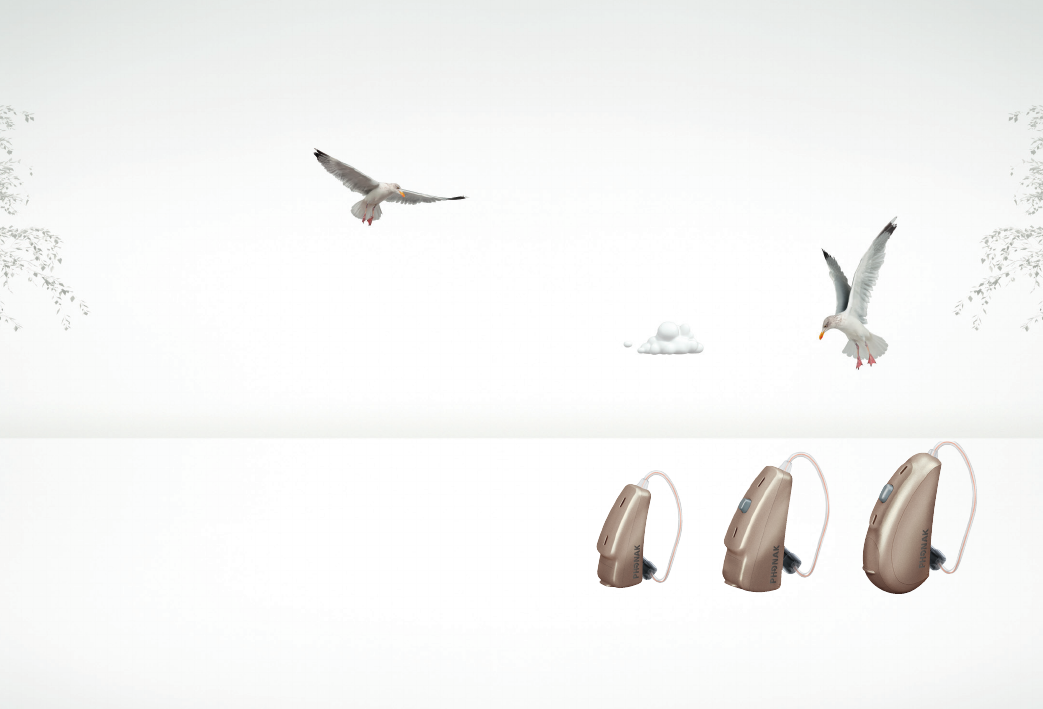
www.phonak.com
Manufacturer:
Phonak AG
Laubisrütistrasse 28
CH-8712 Stäfa
Switzerland
EU Representative:
Phonak GmbH
D-70736 Fellbach-Oeffingen
Germany
Phonak Audéo Q (Q90/Q70/Q50/Q30)
User Guide
029-0254-02/V1.00/2013-03/misyst Printed in Switzerland © Phonak AG All rights reserved

2 3
1. Welcome 5
2. Important safety information:
Please read before operating your hearing aid
for the rst time 6
Hazard warnings 6
Information on product safety 8
3. Hearing aid description 11
4. Step-by-step instructions for using
the hearing aid 15
Step 1. Getting to know your hearing aid 15
Step 2. Battery preparation 17
Step 3. Inserting the battery 18
Step 4. Turning on the hearing aid 18
Step 5. Inserting the hearing aid 20
Step 6. Adjusting the volume control
behind the ear 22
Step 7. Selecting the hearing program
behind the ear 24
Step 8. Removing the hearing aid 25
Step 9. Turning off the hearing aid 26
Step 10. Changing the battery 26
5. Care and maintenance 28
6. Troubleshooting 30
7. Wireless Accessories 32
8. Service and warranty 34
9. Compliance information 36
10. Information and description of symbols 39
Contents
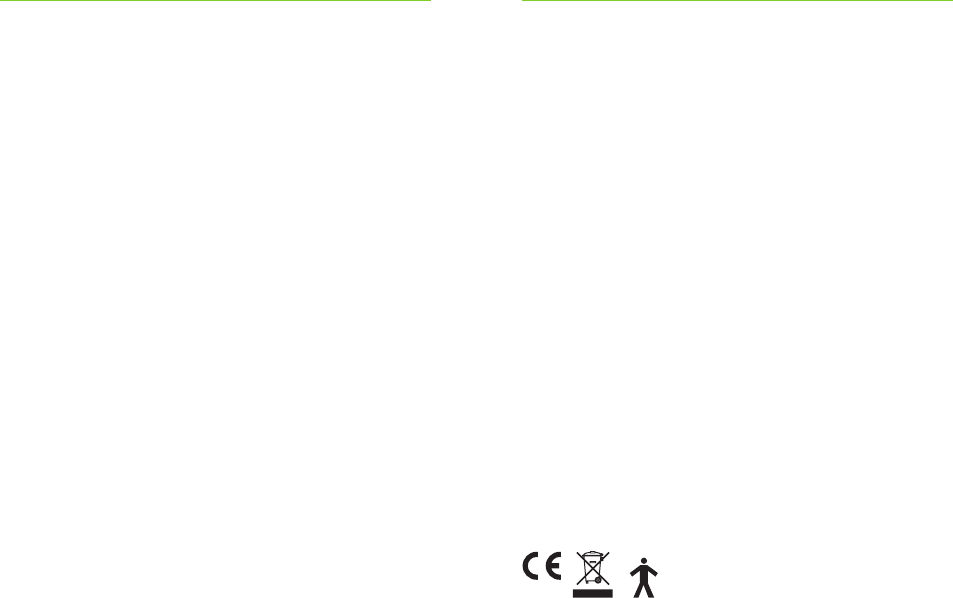
4 5
0459
1. Welcome
Your new hearing aid is a premium Swiss quality product.
It was developed by Phonak, one of the world‘s leading
companies in hearing technology. Your hearing aid offers
the most modern digital hearing technology currently
available on the market.
Please read these user instructions thoroughly in order to
benefit from all the possibilities your new hearing aid has
to offer. With proper use and care, you will be able to
enjoy your hearing aid for many years to come.
If you have any questions, please consult your hearing
care professional.
Phonak - life is on www.phonak.com
This user guide is valid for:
Wireless models
Phonak Audéo Q90-312
Phonak Audéo Q90-312T
Phonak Audéo Q70-312
Phonak Audéo Q70-312T
Phonak Audéo Q50-312
Phonak Audéo Q50-312T
Phonak Audéo Q30-312
Phonak Audéo Q30-312T
Non wireless models
Phonak Audéo Q90-10
Phonak Audéo Q70-10
Phonak Audéo Q50-10
Phonak Audéo Q30-10

6 7
Please read the information on the following pages
before using your hearing aid.
A hearing aid will not restore normal hearing and will not
prevent or improve a hearing impairment resulting from
organic conditions. Infrequent use of a hearing aid does
not permit a user to attain full benefit from it. The use of
a hearing aid is only part of hearing habilitation and may
need to be supplemented by auditory training and
instruction in lipreading.
2.1 Hazard warnings
!The intended use of hearing aids is to amplify and
transmit sound to the ears and hereby compensate
for impaired hearing. The hearing aids (specially
programmed for each hearing loss) must only be used
by the intended person. They should not be used by
any other person as they could damage hearing.
2. Important safety information
!Changes or modifications to the hearing aid that
were not explicitly approved by Phonak are not
permitted. Such changes may damage your ear or the
hearing aid.
!Do not use the hearing aids in explosive areas (mines
or industrial areas with danger of explosions).
!Hearing aid batteries are toxic if they are swallowed!
Keep out of reach of children and mentally challenged
people or pets. If batteries are swallowed, consult
your physician immediately!
!If you feel pain in or behind your ear, if it is inflamed
or if skin irritation and accelerated accumulations of
ear wax occur, please check with your hearing care
professional or physician.
! In very rare cases, the dome can remain in your ear
canal when removing the hearing tube from the ear.
In the unlikely case that the dome does get stuck in
your ear canal, it is strongly recommended to see a
physician for safe removal.

8 9
!Hearing programs in the directional microphone
mode reduce background noises. Please be aware
that warning signals or noises coming from behind,
e. g. cars, are partially or entirely suppressed.
! The hearing aid contains small parts that can cause
choking, if swallowed by children. Keep out of reach
of children and mentally challenged people or pets.
If swallowed, consult a physician or hospital
immediately.
! External devices may only be connected if they
have been tested in accordance with corresponding
IECXXXXX standards. Only use accessories approved
by Phonak AG, to avoid any electrical shock.
2.2 Information on product safety
I Never immerse your hearing aid in water! Protect it
from excessive moisture. Always remove your hearing
aid before showering, bathing, or swimming, as the
hearing aid contains sensitive electronic parts.
I Protect your hearing aid from heat (never leave near
a window or in the car.) Never use a microwave or
other heating devices to dry your hearing aid. Ask
your hearing care professional about suitable drying
methods.
I When you are not using your hearing aid, leave the
battery compartment open so that any moisture can
evaporate. Make sure that you always completely dry
your hearing aid after use. Store the hearing aid in a
safe, dry and clean place.
I Do not drop your hearing aid! Dropping onto a hard
surface can damage your hearing aid.
I Always use new batteries for your hearing aid. In case
a battery is leaking, replace it immediately with a
new one to avoid any skin irritation. You can return
used batteries to your hearing care professional.
I Remove the battery if you are not using your hearing
aid for a long period of time.
2. Important safety information

10 11
The following user instructions describe Receiver-In-
Canal (RIC) hearing aid models.
RIC hearing aids can be adapted with a variety of
earpieces.
On the following pages use the labeled drawings to
identify the hearing aid and earpiece that you use.
The following table shows what battery you need for your
hearing aid model.
Model Zinc air battery size IEC ANSI
(marking on package) code code
Q-10 10 (yellow) PR70 7005ZD
Q-312 312 (brown) PR41 7002ZD
Q-312T 312 (brown) PR41 7002ZD
3. Hearing aid description
I X-ray radiation (e. g. CT scans, MRI scans) may
adversely affect the correct functioning of your
hearing aids. We recommend that you remove them
before undergoing X-ray procedures and keep them
outside the room.
I Do not use your hearing aid in areas where electronic
equipment is prohibited.
2. Important safety information

12 13
Q-10 and
Q-312 models
Q-312T model Q-10 and
Q-312 models
Q-312T model
a
b
c
d
a
b
c
d
f a
b
c
a
b
c
d
f
d
Option A: with Dome
a Earpiece: Dome (detachable)
b Retention
c External Receiver cable
d Microphone inputs
Program button or volume control*
f Battery compartment with ON/OFF switch
* Not available with Q-10 model
Option B: with cShell
a Earpiece: cShell
b External Receiver cable
c Microphone inputs
d Program button or volume control*
Battery compartment with ON/OFF switch
* Not available with Q-10 model
3. Hearing aid description

14 15
Q-10 and
Q-312 models
Q-312T model
d
c
ba
fa
b
c
d
f
Option C: with SlimTip
a Removal handle
b Earpiece: SlimTip (detachable)
c External Receiver cable
d Microphone inputs
Program button or volume control*
f Battery compartment with ON/OFF switch
* Not available with Q-10 model
The following chapter provides step-by-step instructions
on how to use your hearing aid. Please follow these steps
carefully. In the drawings, the parts that are particularly
important for each step are shown in green.
Step 1. Getting to know your hearing aid
Take the hearing aid in your hand and try out the hearing
aid controls. This will make it easier for you to feel for
and operate the controls later on when wearing the
hearing aid.
4. Step-by-step instructions
for using the hearing aid
3. Hearing aid description
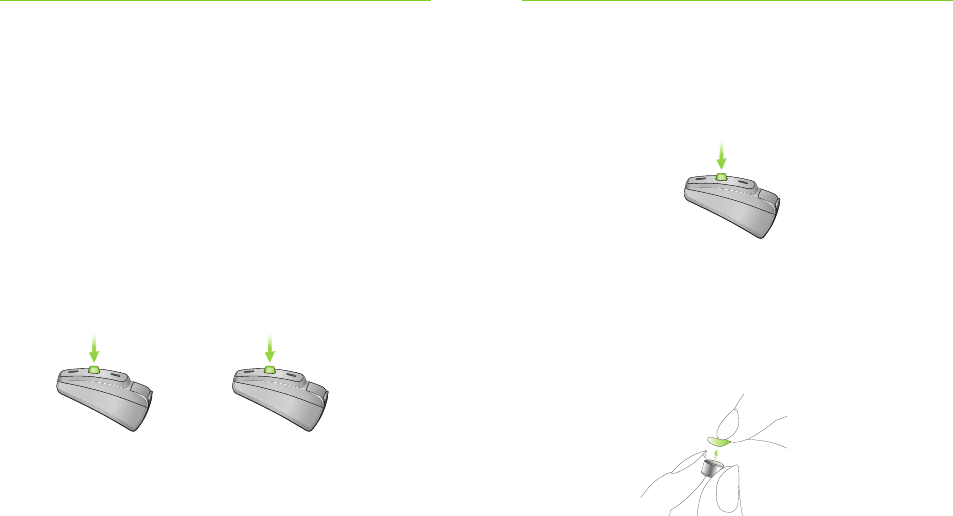
16 17
Fig. 1a
Decrease
volume
Increase
volume
Fig. 1b
Fig. 2
Hearing program selector option
In order to change a hearing program, press the button
displayed in (Fig. 1b).*
Step 2. Battery preparation
Remove the protective foil from the new battery (Fig. 2).
Wait for two minutes before inserting to activate the
battery.
* Option/Function not available for Q-10 model
Your hearing care professional can configure the push
button as either a volume control or a hearing program
selector. Consult your hearing care professional to
determine which option is active in your hearing aid.
Volume control option
To increase the volume, press the button on your right
hearing aid. To decrease the volume, press the button on
your left hearing aid (Fig. 1a).*
Left hearing aid Right hearing aid
* Option/Function not available for Q-10 model
4. Using your hearing aid

18 19
Fig. 4
Fig. 3
Step 3. Inserting the battery
Take the hearing aid in your hand and open the battery
door. Insert the battery so that you see the + symbol on
the battery (Fig. 3).
Step 4. Turning on the hearing aid
The hearing aid is switched on by closing the battery
compartment (Fig. 4).
I Open and close the battery compartment gently
and carefully.
I Check if you feel resistance when closing the
battery compartment. Check to make sure the
battery is correctly inserted and in the correct
direction. If the battery is inserted the wrong way,
the hearing aid will not work and the battery
compartment can be damaged.
The hearing aid is now switched on. It can take up to
15 seconds before it starts.
(When you wear the hearing aid, you will hear an
acoustic signal).
4. Using your hearing aid
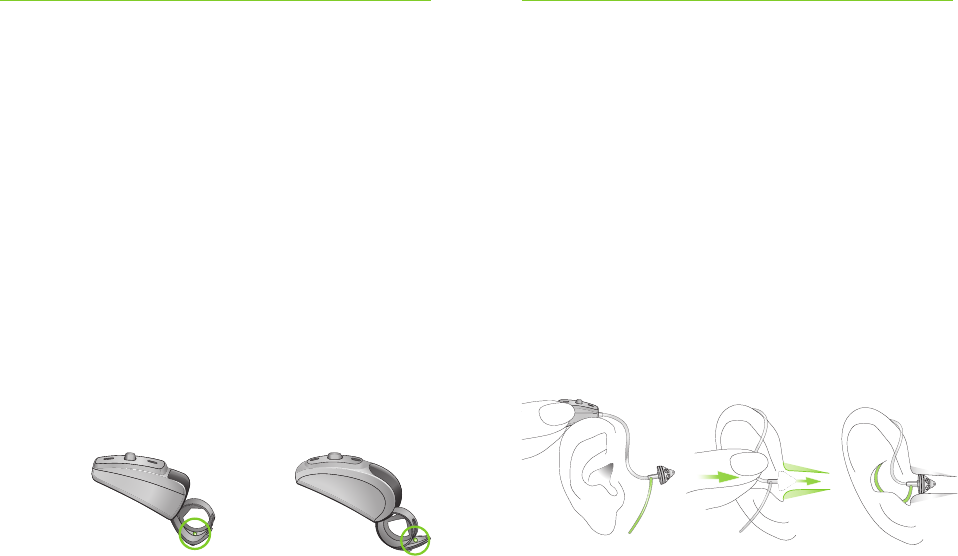
20 21
Q-10 and
Q-312 models
Q-312T model
Fig. 5b Fig. 5c Fig. 5d
Fig. 5a
Step 5. Inserting the hearing aid
This step shows you how to correctly insert the hearing
aid. The instructions apply for all hearing aid models. The
type of earpiece determines how the hearing aid is
inserted.
I Each hearing aid is individually programmed for
your right or left ear. For the first step identify
right and left so you will be able to insert your
hearing aid in the correct ear.
Step 5.1 Identifying the hearing aids for the right and
left ear
Side indicator:
right = red
left = blue
Step 5.2 Inserting a hearing aid with a dome
Before inserting the dome, check that it is correctly
attached to the Receiver (dome length is completely slid
over the Receiver spout). With your right hand, place the
right hearing aid (red mark on the hearing aid, see
step5.1) behind your right ear (Fig. 5b). Take the Receiver
cable between your thumb and forefinger. Insert the
dome deep enough into the ear canal so that the hearing
tube lies flat on your ear (Fig. 5c). If your hearing aid has
a retention cord, then press it into the bowl of the ear in
order to retain the dome in the ear canal (Fig. 5d).
4. Using your hearing aid
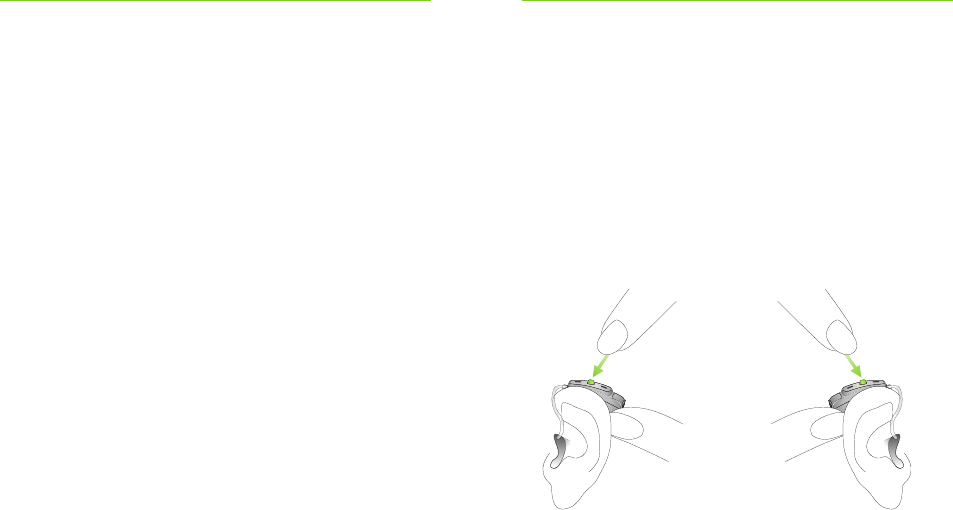
22 23
Increase volumeDecrease volume
Fig. 6
If you have problems inserting the hearing aid, use your
other hand to gently pull your earlobe downwards. This
opens the ear canal a little more and you can gradually
rotate the dome until it fits correctly.
You have now successfully inserted the right hearing aid.
Now insert your left hearing aid in the same way (marked
in blue, see step 5.1)
Step 5.3 For inserting a hearing aid with a cShell or
SlimTip
Follow the instructions in Step 5.2, as this procedure is
identical.
Step 6. Adjusting the volume control behind the ear*
Your hearing care professional can configure the push
button as either a volume control or a program selector.
Consult your hearing care professional to determine
which option is active in your hearing aid.
* Option/Function not available for Q-10 model
To increase the volume, press the button on your right
hearing aid. To decrease the volume, press the button of
your left hearing aid. Use your thumb to lightly support
the hearing aid (Fig. 6).
Left hearing aid Right hearing aid
4. Using your hearing aid
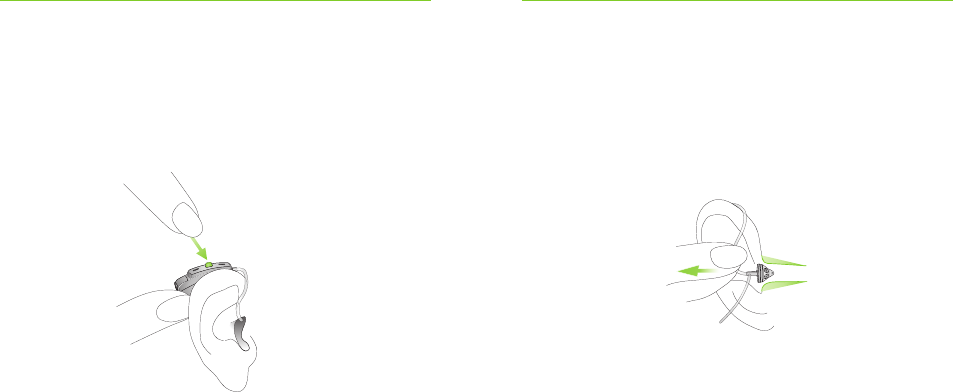
24 25
Fig. 7
Fig. 8
Step 7. Selecting the hearing program behind the ear*
In order to select or change a hearing program with the
hearing aid, press the button displayed in (Fig. 7).
If you press it again, you change to the next program.
A signal indicates the change.
The signal tone can only be easily heard if you have
turned on the hearing aid and you are wearing it
correctly behind the ear.
* Option/Function not available for Q-10 model
Step 8. Removing the hearing aid
Step 8.1 Removing a hearing aid with a dome
Grasp the hearing aid by the Receiver cable and carefully
remove it from your ear (Fig. 8).
! In very rare cases, the dome can remain in your ear
canal when removing the hearing aid from the ear.
In the unlikely case that the dome does get stuck in
your ear canal, it is strongly recommended to see a
medical specialist for safe removal.
Step 8.2 Removing a hearing aid with cShell or SlimTip
Follow the instructions in Step 8.1, as this procedure is
identical.
4. Using your hearing aid

26 27
Fig. 9
Step 9. Turning off the hearing aid
You can turn off your hearing aid by opening the battery
compartment (Fig. 9).
Step 10. Changing the battery
Your hearing aid will indicate with a double beep, that
the battery soon needs to be changed. You typically have
up to 30 minutes to change the battery, however this can
differ and might be considerably shorter. We recommend
that you always keep a spare battery on hand.
4. Using your hearing aid

28 29
Daily
Inspect the earpiece for earwax and moisture deposits.
Clean the surfaces with a lint-free cloth. Never use
cleaning agents such as household detergents, soap, etc.
for cleaning your hearing aid. It is not recommended to
rinse with water. If you need to clean your hearing aid
intensively, ask your hearing care professional for advice
and information on filters or drying capsules.
Weekly
Clean the earpiece with a soft, damp cloth or with a
special cleaning cloth for hearing aids. For more in depth
maintenance instructions or for more than basic cleaning,
please see your hearing care professional.
5. Care and maintenance
Diligent and routine care of your hearing aid contributes
to outstanding performance and a long service life.
Please use the following specifications as a guideline:
General information
Before using hair spray or applying cosmetics, you should
remove your hearing aid from your ear, because these
products may damage it.
Never wash or clean the microphone inputs (see
chapter 3). Doing so could cause it to lose its special
acoustic features.

30 31
Whistling
Check whether the earpiece is correctly and firmly fitted.
If this is the case, but the problem persists, please consult
with your hearing care professional.
Pain or inflammation in your ear
Remove the hearing aid and consult with your hearing
care professional. If the problem is serious, please contact
your physician.
Hearing aids sound softer than usual / no sound
First check whether you can adjust and make the sound
louder with the volume control. Then check the earpiece
for earwax residue and clean if necessary. Check whether
the battery is correctly inserted and properly fitted, adjust
the fit if necessary. If there is no improvement, change
the battery. If the problem persists, contact your hearing
care professional.
Battery discharges too quickly
Insert a new battery and make note of exactly how long
it lasts. Contact your hearing care professional with this
information, they will be able to help and advise you.
Crackling or buzzing background noises
Check the earpiece for earwax residue. If the problem
persists, contact your hearing care professional.
6. Troubleshooting
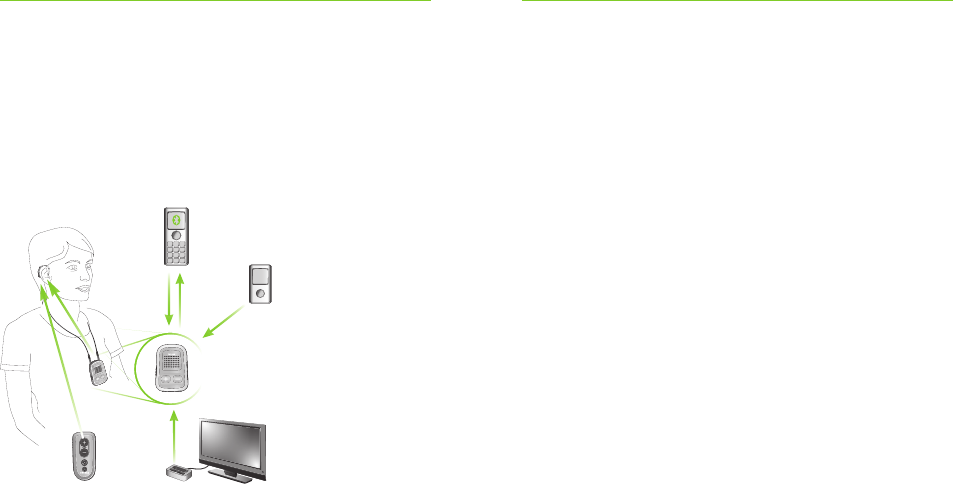
32 33
TVLinkRemote controls
Wireless audio
streaming device
Cell phone
MP3 Player/
Audio source*
power
audio
Phonak has developed a broad range of wireless
accessories for a convenient control of your hearing aid.
It includes remote controls, wireless audio streaming
devices for connection to TV (via TVLink), cell phones etc.
refer to schematic below:
* Non wireless audio sources can be connected by wiring
directly to the wireless audio streaming device
7. Wireless Accessories

34 35
8. Service and warranty
8.1 Local warranty
Please ask the hearing care professional, where you
purchased your hearing aid, about the terms of the local
warranty.
8.2 International warranty
Phonak offers a one year limited international warranty,
valid starting from the date of purchase. This limited
warranty covers manufacturing and material defects in
the hearing aid itself, but not accessories such as
batteries, tubes, earmolds, external receivers. The
warranty only comes into force if a proof of purchase is
shown.
The international warranty does not affect any legal
rights that you might have under applicable national
legislation governing sale of consumer goods.
8.3 Warranty limitation
This warranty does not cover damage from improper
handling or care, exposure to chemicals or undue stress.
Damage caused by third parties or non-authorized service
centers renders the warranty null and void. This warranty
does not include any services performed by a hearing care
professional in their office.
Serial number (left side):
Serial number (right side):
Date of purchase:
Authorized hearing care
professional
(stamp/signature):

36 37
The wireless models listed in chapter 1 are certified
under:
USA FCC ID: KWC-WHSSAN1
Canada IC: 2262A-WHSSAN1
Notice 1:
This device complies with Part 15 of the FCC Rules and
with RSS-210 of Industry Canada. Operation is subject to
the following two conditions:
1) this device may not cause harmful interference, and
2) this device must accept any interference received,
including interference that may cause undesired
operation.
Notice 2:
Changes or modifications made to this device not
expressly approved by Phonak may void the FCC
authorization to operate this device.
Europe:
Declaration of Conformity
Hereby Phonak AG declares that this Phonak product
meets the requirements of the Medical Devices Directive
93/42/EEC as well as the Radio and Telecommunications
Terminal Equipment Directive 1999/5/EC. The full text of
the Declaration of Conformity can be obtained from the
manufacturer or the local Phonak representative whose
address can be taken from the list on www.phonak.com
(Phonak worldwide locations).
Australia:
Supplier Code Number E N15398
New Zealand:
Supplier Code Number Z1285
9. Compliance information
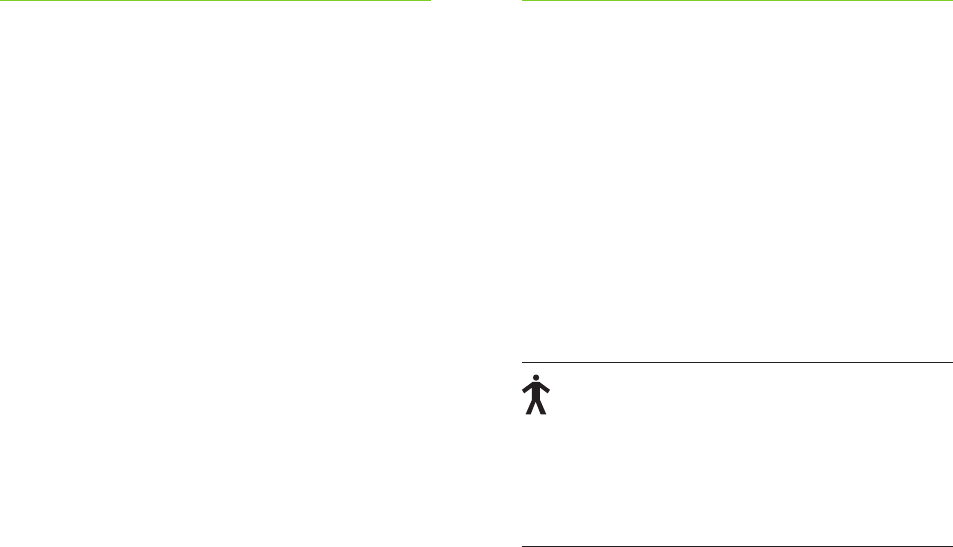
38 39
Notice 3:
This device has been tested and found to comply with the
limits for a Class B digital device, pursuant to Part 15 of
the FCC Rules and ICES-003 of Industry Canada.
These limits are designed to provide reasonable
protection against harmful interference in a residential
installation. This device generates, uses and can radiate
radio frequency energy and, if not installed and used in
accordance with the instructions, may cause harmful
interference to radio communications. However, there
is no guarantee that interference will not occur in a
particular installation. If this device does cause harmful
interference to radio or television reception, which can be
determined by turning the equipment off and on, the user
is encouraged to try to correct the interference by one or
more of the following measures:
SReorient or relocate the receiving antenna.
SIncrease the separation between the device and
receiver.
SConnect the device into an outlet on a circuit different
from that to which the receiver is connected.
SConsult the dealer or an experienced radio/TV
technician for help.
9. Compliance information 10. Information and description of
symbols
With the CE symbol, Phonak AG
confirms that this Phonak product
– including accessories – meets the
requirements of the Medical Devices
Directive 93/42/EEC as well as the
R&TTE Directive 1999/5/EC on radio
and telecommunications equipment.
The numbers after the CE symbol
correspond to the code of certified
institutions that were consulted under
the above-mentioned directives.
This symbol indicates that the
products described in these
user instructions adhere to the
requirements for an applied part of
Type B of EN 60601-1. The surface
of the hearing aid is specified as an
applied part of Type B.
C
XXXX

40 41
10. Information and description of symbols
EMC and Radio communications
compliance label Australia.
E
This symbol indicates that it is
important for the user to read and
take into account the relevant
information in these user guides.
This symbol indicates that it is
important for the user to pay
attention to the relevant warning
notices in these user guides.
Important information for handling
and product safety.
The product is designed such that
it functions without problems or
restrictions if used as intended,
unless otherwise noted in these
user guides.
R
!
I
Operating
conditions
Temperature: –20° to +60° Celsius
(–4° to +140° Fahrenheit)
Humidity transportation: Up to 90%
(non condensing)
Humidity storage: 0% to 70%, if not
in use. See instruction in chapter 2.2
regarding drying the hearing aid after
use.
Atmospheric pressure: 200 hPA to
1500 hPa
The symbol with the crossed-out
garbage bin is to make you aware
that this hearing aid may not be
thrown away as normal household
waste. Please dispose of old or unused
hearing aids, at waste disposal sites
intended for electronic waste, or
give your hearing aid to your hearing
care professional for disposal. Proper
disposal protects the environment and
health.
Transport
and storage
conditions
T
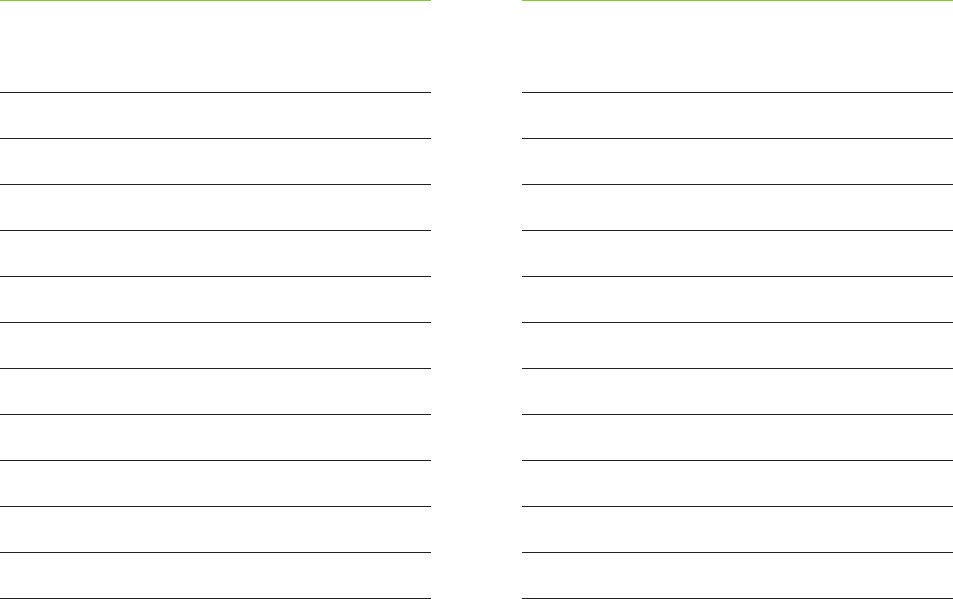
42 43
Notes